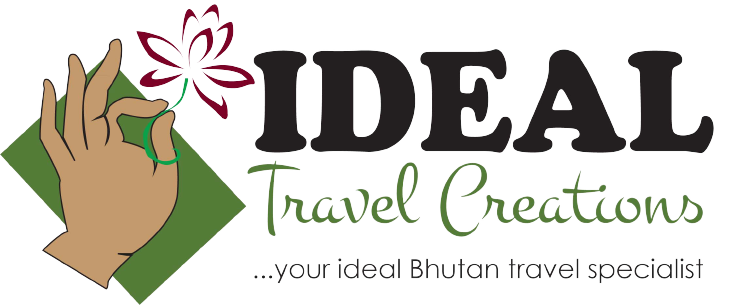Places to visit in Thimphu
Explore the Heart of Bhutan’s Capital, Where Tradition Meets Tranquility.
Thimphu, the capital city of Bhutan offers a unique travel experience with its serene monasteries, vibrant markets, and breathtaking vistas. Thimphu’s blend of ancient traditions and modern development creates a captivating destination. Whether exploring historic monasteries, mingling with locals at the market, or enjoying the panoramic views, Thimphu is a city that leaves a lasting impression on every visitor.
When exploring these sights in Thimphu, it’s advisable to check for any specific visiting hours, cultural sensitivities, and any events or festivals that may enhance your experience.
Here are some museums, monuments, temples, and other sights of interest to explore in Thimphu:
Tashichho Dzong
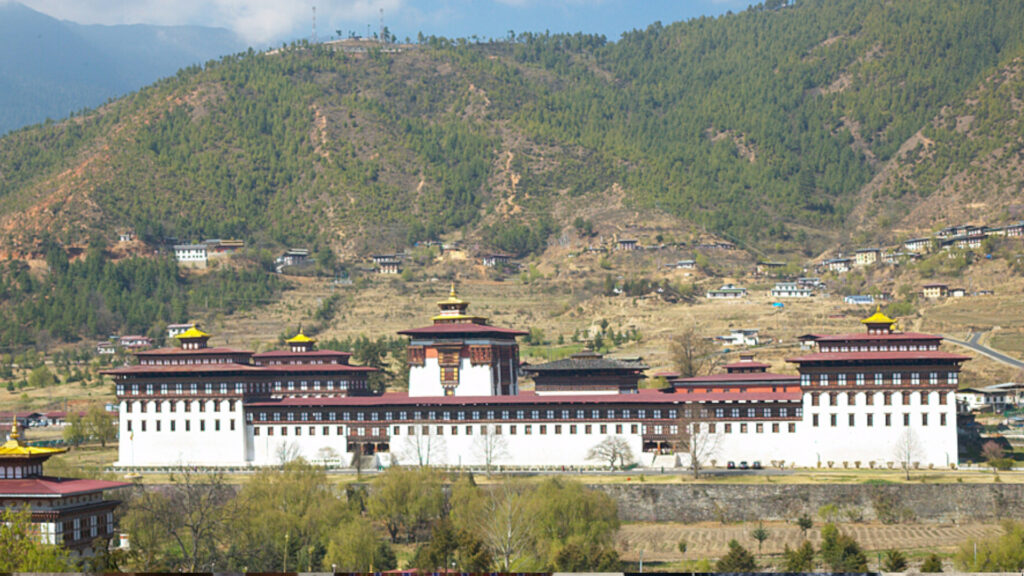
Tashichho Dzong is a majestic fortress and monastery that serves as the seat of the Bhutanese government. The intricate architecture, surrounded by lush gardens and overlooking the Wang Chhu River, makes it a symbol of Bhutanese culture and heritage. Visitors can explore the intricate frescoes, religious artifacts, and attend the colorful Tshechu festivals held here. It is a Buddhist monastery and fortress. It is also the seat of the His Majesty, the King of Bhutan and the Summer residence of the Monk Body of Bhutan. The main structure of the whitewashed building is two-storied with three-storied towers at each of the four corners topped by triple-tiered golden roofs. There is also a large central tower or “utse”.
National Memorial Chhorten
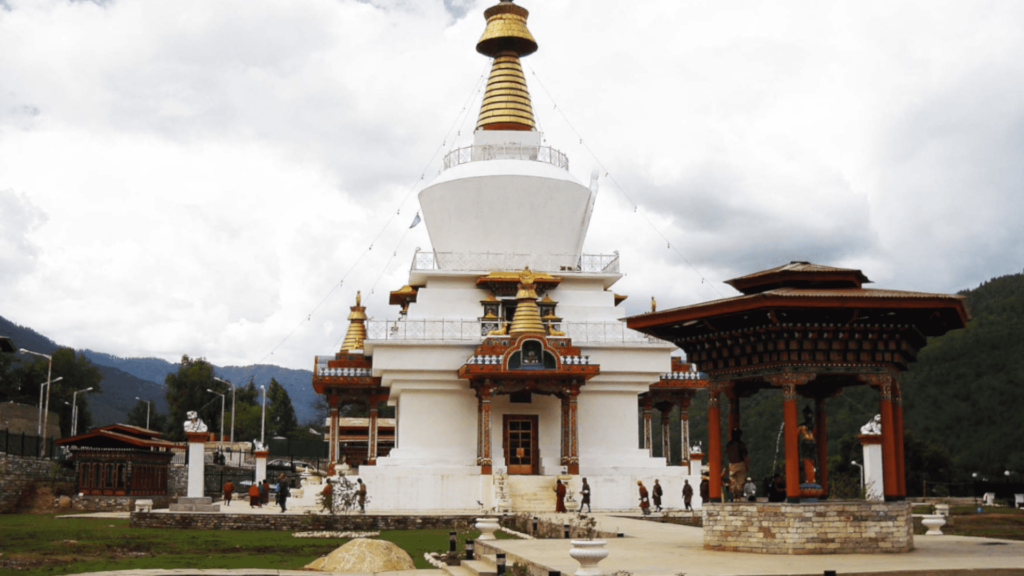
This iconic chorten, built in memory of the third king of Bhutan, Jigme Dorji Wangchuck, is a prominent landmark in Thimphu. Surrounded by prayer wheels and serene gardens, the chorten is a place of worship and a hub for locals who come to circumambulate and offer prayers. The National Memorial Chorten shines with the white color and the spires of gold and is one of the land marks in Thimphu. It was constructed in 1974 to honor the third King of Bhutan, His Majesty Jigme Dorji Wangchuck, also known as the Father of Modern Bhutan. The Chhorten is situated on Doeboom Lam in the south-central part of the capital city. You can see Mandalas, paintings, shrines, and statues dedicated to the King.
Kuenselphodrang & Buddha Dordenma Statue
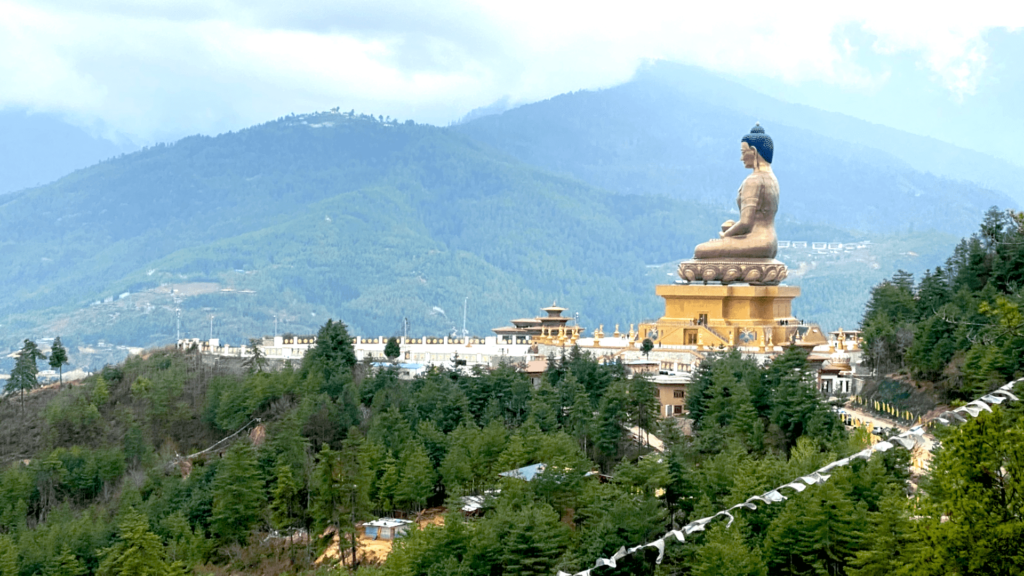
The Kuenselphodrang and the Buddha Dordenma Statue is one of the most popular landmarks in Thimphu. The largest statue of the Buddha Dordenma or Shakyamuni Buddha sits on this hill top overlooking the Thimphu Valley. The statue stands at a height of 51.5 meters (169 feet), making it one of the largest Buddha Shakyamuni statues in the world. It is made of bronze and gilded in gold. The statue was constructed to celebrate the 60th anniversary of the fourth king of Bhutan and to fulfill a prophecy that building a large Buddha statue would bring peace and happiness to the world. In addition to serving as a spiritual and religious centre, the place also offers panoramic views of the Thimphu Valley.
Kuenselphodrang Nature Park
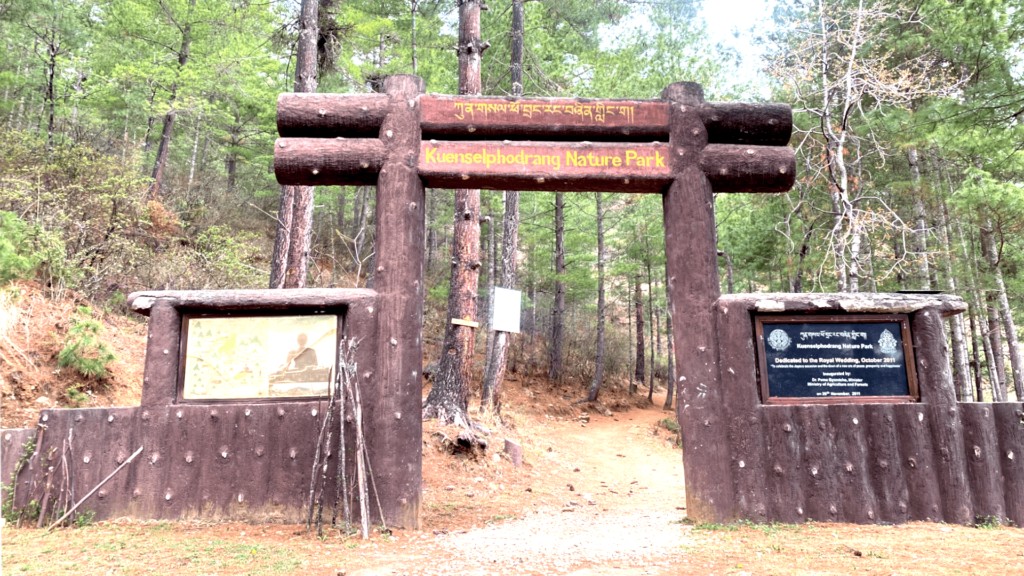
A few hundred meters away from the Buddha Point lies the Kuensel Phodrang Nature Park. This Park was established in 2011 and is one of the most visited parks in Thimphu. The area gets its name from “Changri Kuensel Phodrang” where the palace of the 13th Druk Desi once stood. Together with the opportunity to be amongst the pine woods and nature, the are also offers breathtaking views and experience of the soothing himalayan breeze. The idea behind this part is to protect the forest are surrounding the Buddha Point and is significant in spheres of culture, religion, biodiversity, tourism and recreations. This park is connected with a nature trial which starts from Changangkha Lhakhang and ends at Debsi giving hikers and biking enthusiasts among the most memorble experiences.
Simply Bhutan
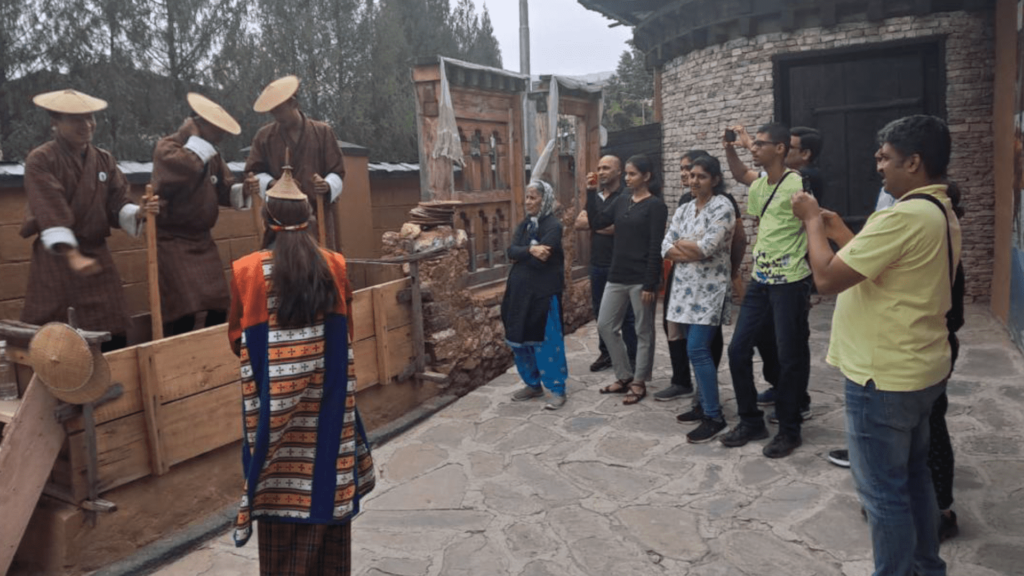
Gain insights into Bhutanese rural life and traditions at the “ Simply Bhutan”. Explore exhibits showcasing traditional artifacts, tools, and learn about Bhutanese way of life in the ancient times. Simply Bhutan Museum showcases the rich Bhutanese culture to the world. This is a live museum and displays the impressive traditions giving a glimpse into the country’s history. Visitors also get to enjoy the Bhutanese songs, folk dances and the “Suja” and “Arra” (Traditional Bhutanese butter tea and Local alcohol). One can also live the country’s culture by trying on traditional clothes and archery. Simply Bhutan is also a photo studio, where the Bhutanese culture is promoted and preserved.
Kaja Throm and Centenary Farmers market
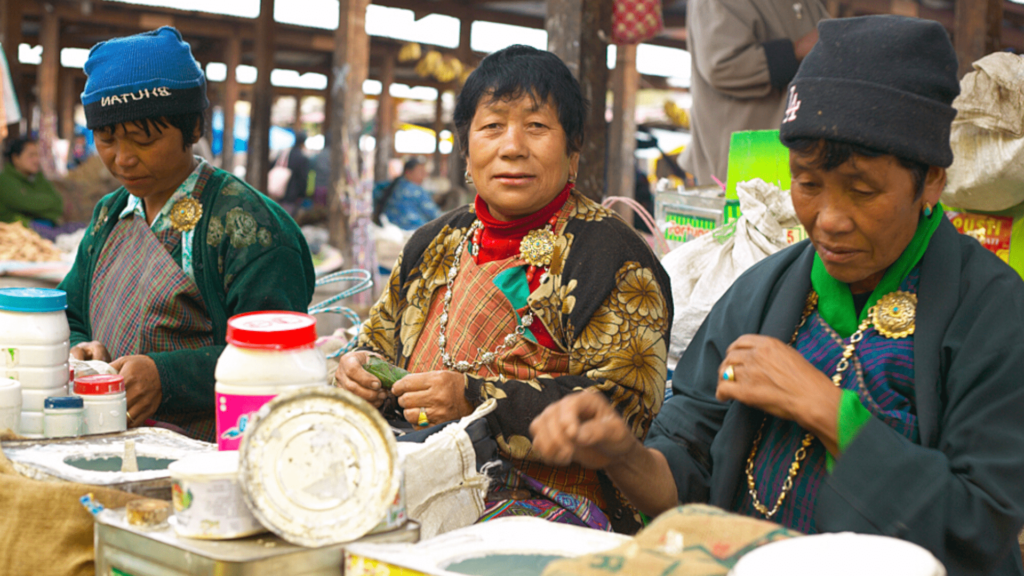
Kaja Throm is among the newest places for people to stroll around or visit in Thimphu. “Throm”means market and this market was built under the command of His Majesty the King with an obejective to bring farmers and local entrepreneurs and entertainment together. The market showcases the best of what locals have to offer to visitors.
Near to this Kaja Throm, we have the Centenary Farmers Market which is specifically built for farmers to sell their produce. Apart from organic home grown produces, the place also sells imported vegetable and fruits and is the main place for residents of thimphu to visit during the weekend to buy their weeks supplies of fruits, vegetables, dairy and meat produce.
VAST Bhutan

VAST (Voluntary Artists Studio) in Thimphu could be among the must visit places for Art Lovers. It was founded in 1998 and the Man behind is Artist Karma Wangdi, populary known as Asha Karma. It’s primary objective is to encourage and promte young artists to promote their talents ands professional artists. The organisation stand with a mission; “Nurturing a creative society”. VAST Bhutan is a Non – profit organisation and works towards creating social awareness with their Art exhibitions and competitions. The organisation has two Art galleries in Thimphu, Alaya Gallery and Bhutan Art Gallery. Bhuta Art Gallery is located in the ground floor of the Le Meridien, Thimphu Hotel and the Alaya gallery is located in Tarayana centre.
Bhutan Postal Museum
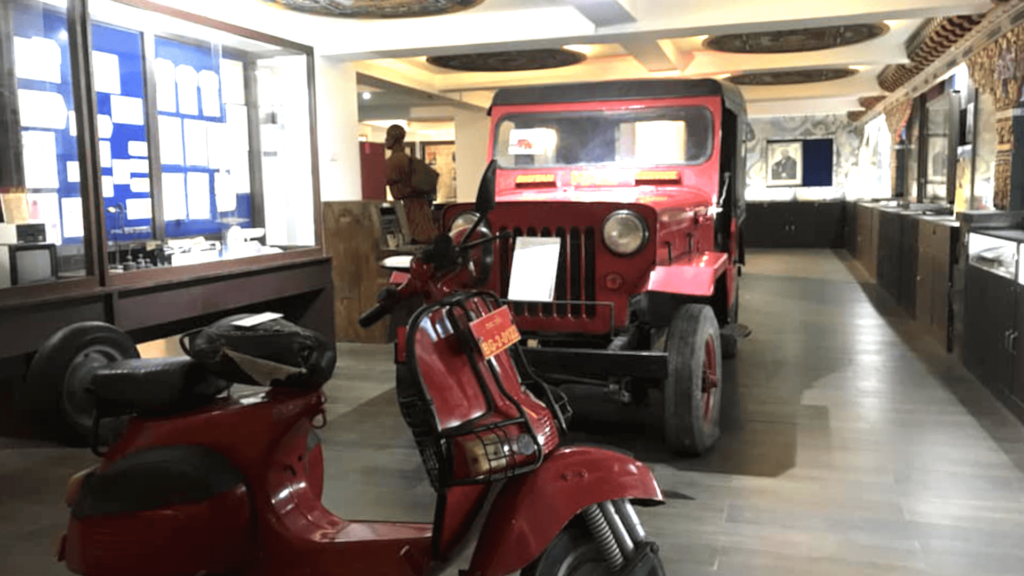
Established to celebrate the 60th Birth anniversary of the Fourth King of Bhutan, His Majesty the King Jigme Singye Wangchuk, the Bhutan Postal Museum narrates the story of the evolution of communication, transportation and postal services in Bhutan. This Story is narrated through the the collection of various anecdotes, artifacts and the rich assortment of stamps the country has produced over the years. The museum has five galleries and an area for multimedia where postal system related documentaries are screened. Connected with the Museum is the Philately shop. A unique feature of the shop is, it specializes in personalized stamps. You can develop personalised stamps with your own photos here and can send post cards to your home country with your personalised stamps. Traditional Bhutanese handmade souvenirs can also be bought here.
Royal textile Academy and National Textile Museum Bhutan
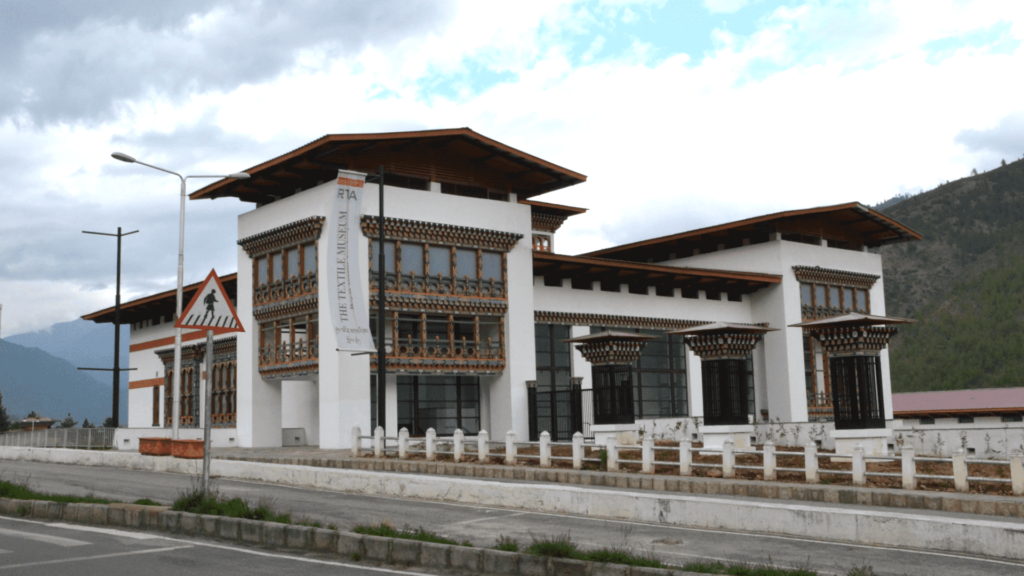
The Royal Textile Academy is Bhutan’s first institution that educates the Bhutanese youth about the conservation, preservation, training, study and exhibition of the country’s textiles. The Academy also provides in bringing about a National Centre for weaving and educating young students in textiles, fabric designs and museum studies. It also serves as a center for tourists, introducing the nation’s masterpiece to its visitors, while expanding the nation’s resource for cultural tourism.
The National Textile Museum was established in the year 2001 and has a good collection of exclusive and antique Bhutanese textile artifacts. The museum was set up with an objective to promote encourage weavers to continue the weaving of traditional Bhutanese textile, Promote Bhutan in the field of textile art and to preserve and promote the history and tradition of Bhutan.
National Institute for Zorig Chusum (13 Arts & Crafts of Bhutan)
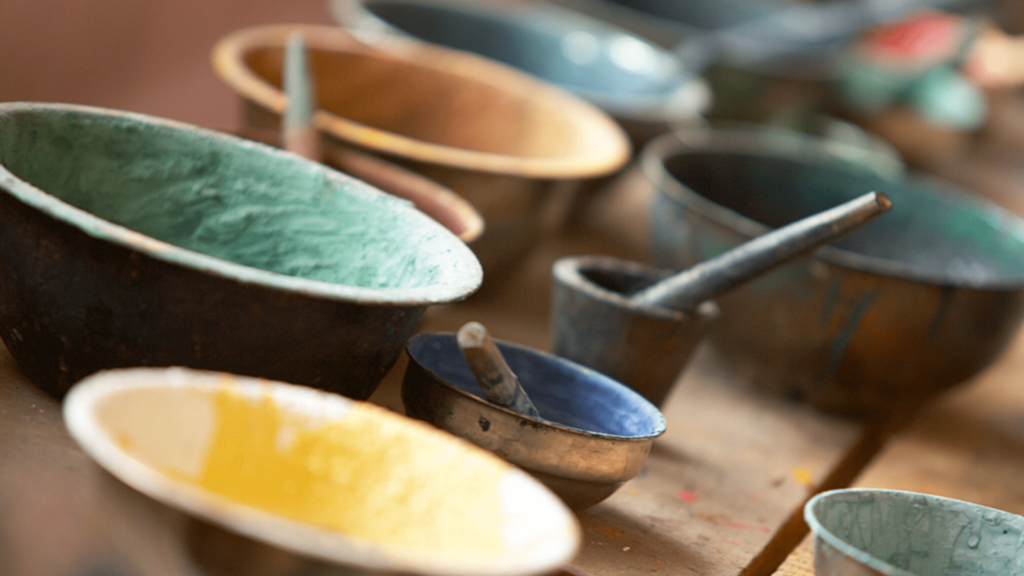
“Zorig Chusum” means “Thirteen Arts and Crafts”. These thirteen art forms are Traditional Painting (Lhazo), Sculpturing (Jinzo), Wood Carving (Shagzo), Calligraphy (Yigzo), Paper making (Dezo), Bronze Casting (Lugzo), Embroidery (Tshemazo), Weaving (Thagzo), Carpentry (Parzo), Masonry (Dozo), Bamboo and cane weaving (Tshazo), Gold/Silver Smithy (Trozo), Black smithy (Garzo). Located at Kawa Jangsa in Thimphu, the institute was established in 1971 as a Painting school with 30 students and two Instructors under the Ministry of Development. It was then established to preserve and promote traditional arts and crafts of Bhutan. In the initial years, students were taught “Shing Tshen gi Rimo” (drawing of House Painting). Today it stands as a premier institute where students are taught the thirteen traditional arts and crafts of Bhutan.
The National Library and Archives of Bhutan
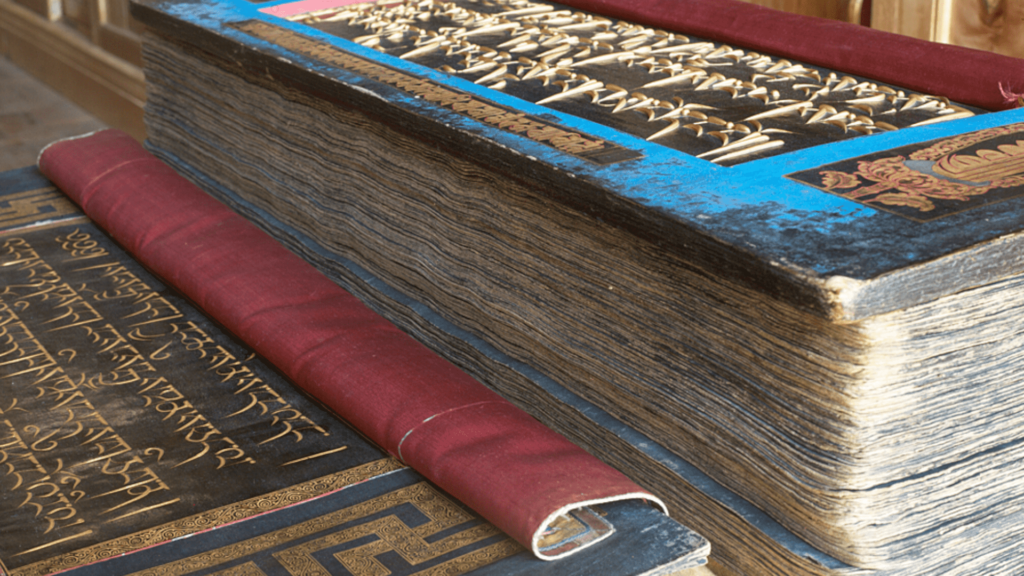
Established in the year 1967 under patronage of Her Majesty Queen Ashi Phuntsho Choden, the National Library initially was started with a small collection of precious texts.The liobrary was first housed in the central tower of the Tashichodzong and was later mnoved to Changangkha as the collections grew. The current building was initiated by the then Home Minister, Lyonpo Tamzhing Jagar. The inauguration and consecration ceremony was held on November 23, 1984. It was inaugurated by His execellency Lyonpo Sangye Penjor, then Minister for Communications and Tourism and the consecration ceremony was performed by H.H. Dilgo Khyentse Rinpoche. The National Library and Archives of Bhutan is a major repository of Bhutan’s literary heritage, especially that of Vajrayana Buddhist texts and archival documents. It continues to build its comprehensive collections through Legal Deposit Act 1999, donations and purchases. It also aspires to strengthen, promote and preserve Intangible Cultural Heritage of Bhutan.
The Folk Heritage Museum
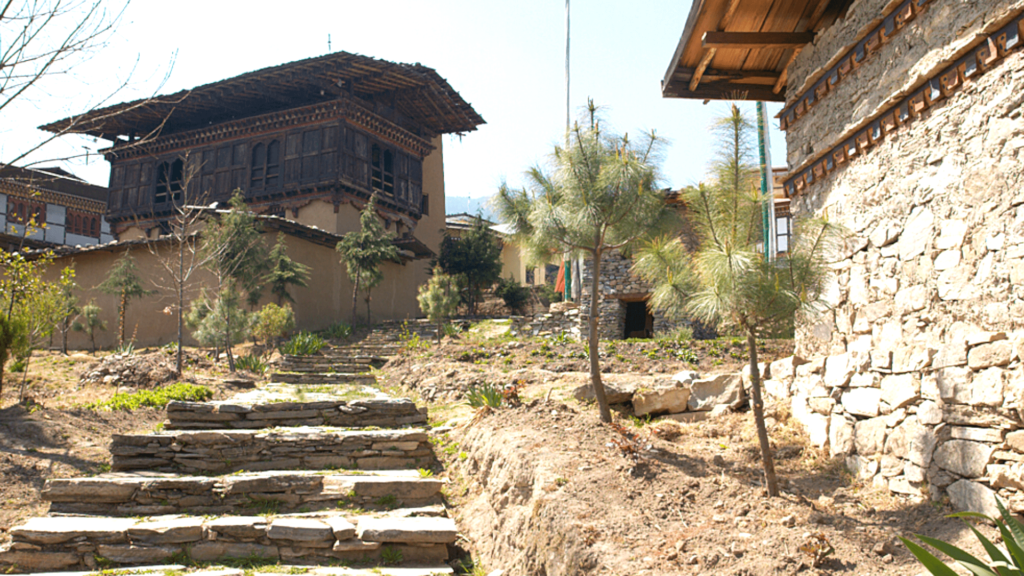
Located in Kawajangsa, Thimphu, the Folk Heritage Museum, also known as Phelchey Toenkhyim was founded by Her Majesty the Queen Mother Ashi Dorji Wangmo Wangchuck on 28th July 2001. The museum is a 3 story 19th century traditional rammed mud and timber house and dipicts a typical Bhutanese houise and lifestyle in the ancient times. The ground floor dipicts a barn, the first floor is a safe store and the top floor is the living and dining area. The museum displays various materials used in day to day life by Bhutanese people in ancients times. Exhibitions includes rural households artifacts, equipment, objects and tools. The museum also regulary holds events for education and cultural demnstrations. The museum also has a restaurant which serves authentic Bhutanese meals.
National Institute of Traditional Medicine OR Faculty of Traditional Medicine
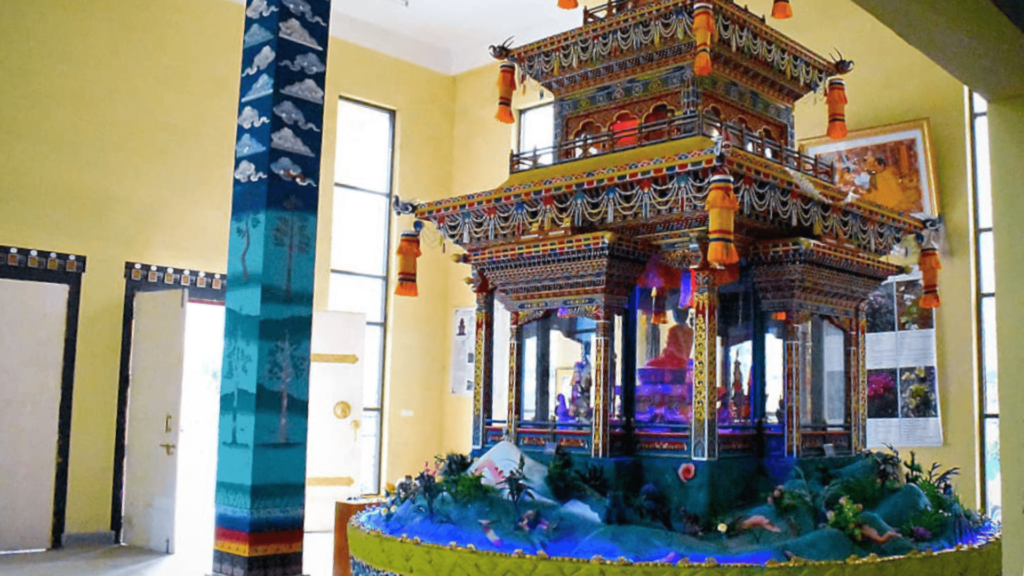
The institute of Traditional Medicine OR The Faculty of Traditional Medicine was established in 1971 as an Indigenous Training Centre. It was initilly set up at at Dechencholing, Thimphu. Eight students were first recruited to undergo a three years sMenpa training (diploma). In 1978 the trainning programme for “Dungtsho” (Degree in Traditional Medicine) was also started following a Royal Command of His Majesty Jigme Singye Wangchuck the fourth King of Bhutan. The centre was upgraded as the National Institute of Traditional Medicine in 1992 and shifted to Kawang Jangsa, Thimphu. The Institute functions as A faculty of Traditional Medicine under the University of Medical Sciences of Bhutan.
The institute collects medicinal plants from remote parts of the Himalayas in Bhutan, process the same in the traditional styles and then distributes pills, ointments and medicinal tea to regional health care units around the country. The instituite is a fully functional traditional medicine hospital where treatments are done following the ancient traditional methods. The institute also has a small museum which covers around 300 herbs, minerals and animal parts. This also includes Cordyceps, Known as “Yartsa Goenbub” in Bhutanese language. This is popular in many countries and consumed as a form of “Himalayan Viagra” and sells at a very high price. “The Celestial City of Medicine” sculpture in the lobby area is also of interest and worth pausing for.
Changangkha Lhakhang
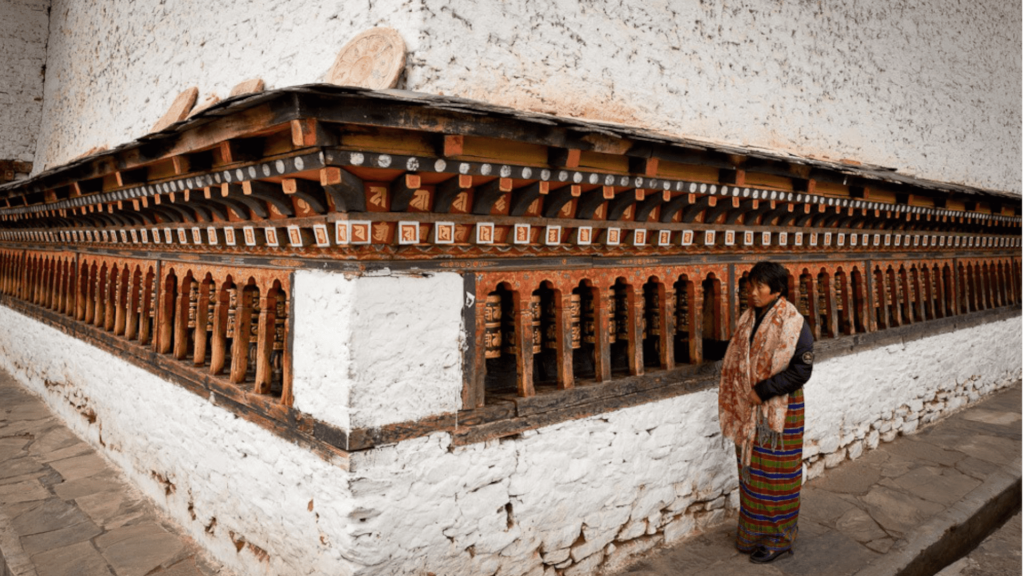
Built in the 12th century, Changangkha Lhakhang is among the oldest temples in the Thimphu Valley. It was first founded by Phajo Drugom Zhipo and overlooks the Thimphu valley. The central statue of the lhakhang is the Chenrizig or “Avolokiteshwara. Other statues includes the statues of Jampelyang and Chagna Dorji among others. The protective deity of the temple is Genyen Domtsangpa and is considered to be the birth deity and protector of children born in Thimphu. Because of this reason, you can see a lot parents with new born babies visiting the temple to obtain the blessings of the protective deity.
Sangaygang View Point or the BBS Tower
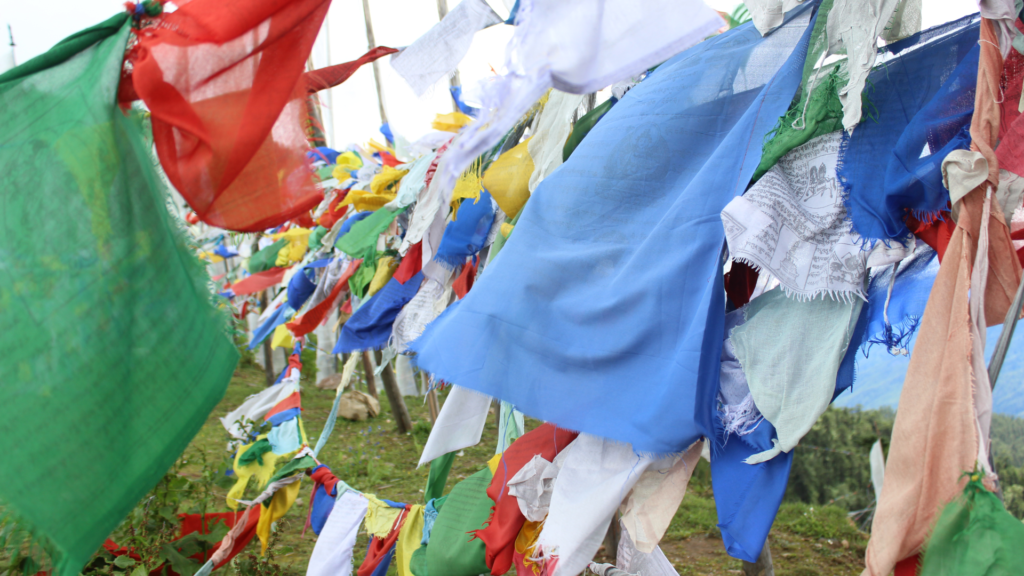
Located around 6 to 7 kms from the Thimphu Main town is the Sangaygang View Point. It is also known as BBS tower to many as the Main Towers of the Bhutan Broadcasting Service is located here. The viewpoint is at an elevation of 2685 meters and offers a panoramic view of the Thimphu Valley. The are is also a haven for morning and evening walks. Before the Kuenselphodrang was built, this place was the most popular viewpoint for Thimphu Valley. The are is surrounded by lush green pine trees and colorful prayer flags flutter as the cool breeze from the Himalayas blows here. You can choose to simply enjoy the view, ride a cycle of have a nice evening walk here.
Takin Preserve centre
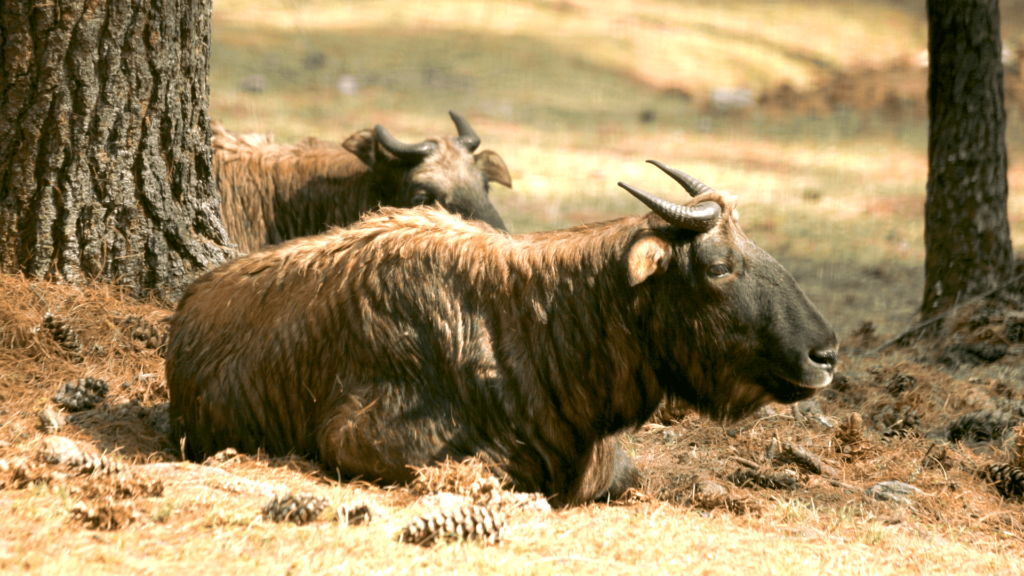
Located just above motithang on the way to Sangaygang Viewpoint is the Takin Preserve Centre. Takin is the national animal of Bhutan and is among the endangered animals in the world. Takin is associated with Bhutanese religious history and mythology. Legend has it that Lama Drukpa Kuenlay also known as the “Divine Madman” created this unique animal which resembles a quaint blend between a cow and a goat. This is the reason behinmd adopting the animal by Bhutan as its’ national animal. Initially it was a mini zoo with other animals such as Muntjac deer, Sambar, and Serow. It was converted into a preserve covering an area of 8.4 acres when it was learnt that the animals refrained from going to the surrounding forests even when it was set free.
Thangthaong Dewachen Nunnery or Zilukha Anim Dratshang (Nunnery)
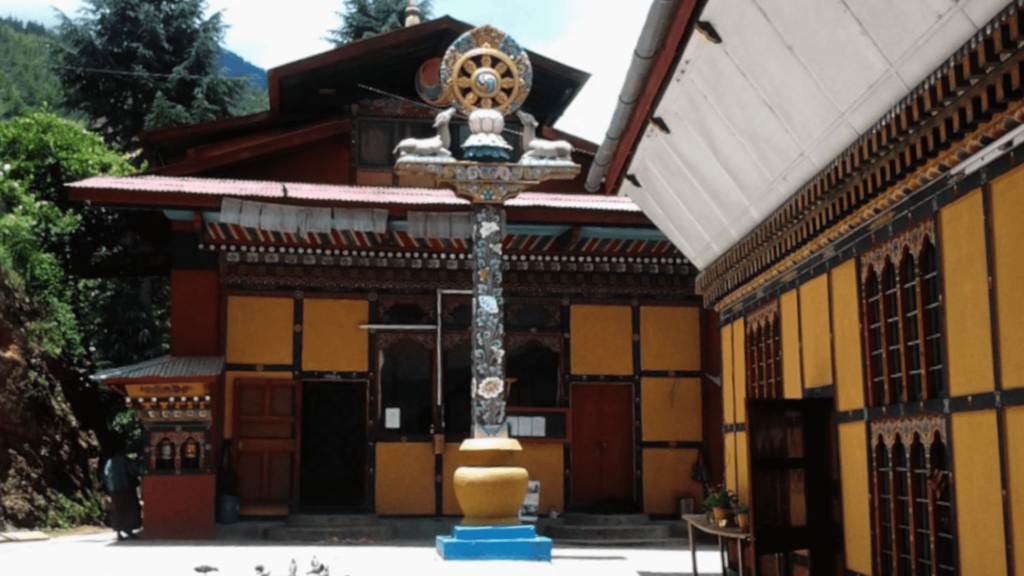
Thangthong Dewachen Nunnery, commonly known as Zilukha Anim Dratshang is located in Zilukha, Thimphu, overlooking the Tashichhodzong. The Nunnery was built in 1976 by the 16th emanation of Thangthong Gyalpo, Drubthob Rikey Jadrel, because of which it is also known by the name of Drubthob Lhakhang. The nunnery currently houses around 60 Nuns.
Choki Traditional Art School
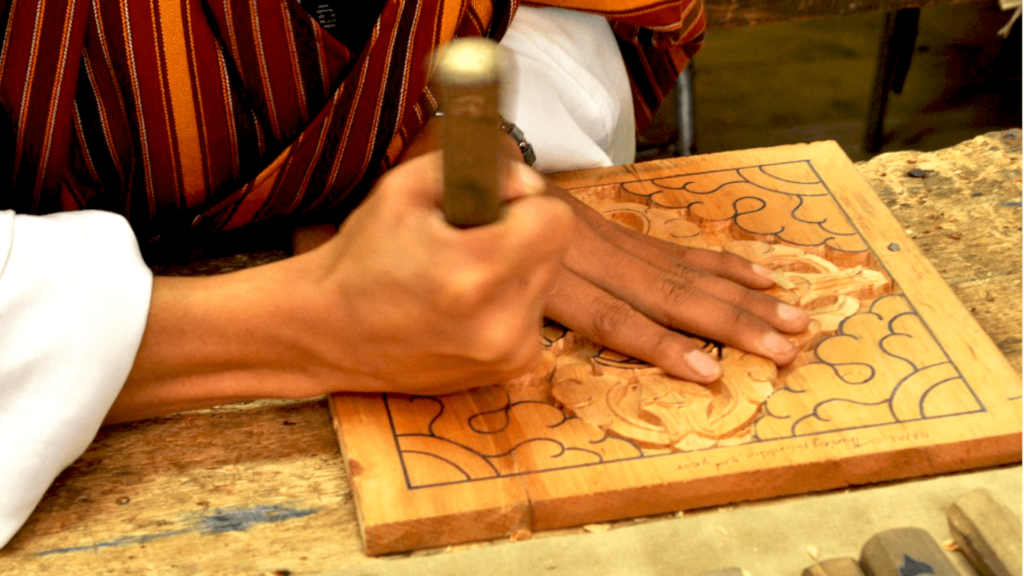
School Traditional Art School is located in Kabesa, around 10 kms away from Thimphu main city. It is a private school which focuses on imparting the knowledge and skills of several traditional Bhutanese Art forms. Choki Traditional Art School provides free education to underprivileged youths who have a keen interest in learning the traditional arts and crafts. It is a full time school with complete curriculum. Currently the school offers basic English, Maths, Dzongkha, IT, and extracurricular activities such as cultural activities, sports, Driglam-Namzha (Bhutan’s code of etiquette), prayers, farming/ gardening and other green values. The Royal Governmnet of Bhutan has recognized and certified the school as a formal private training institute and has also won several open National Competitions.
Tango Monastery
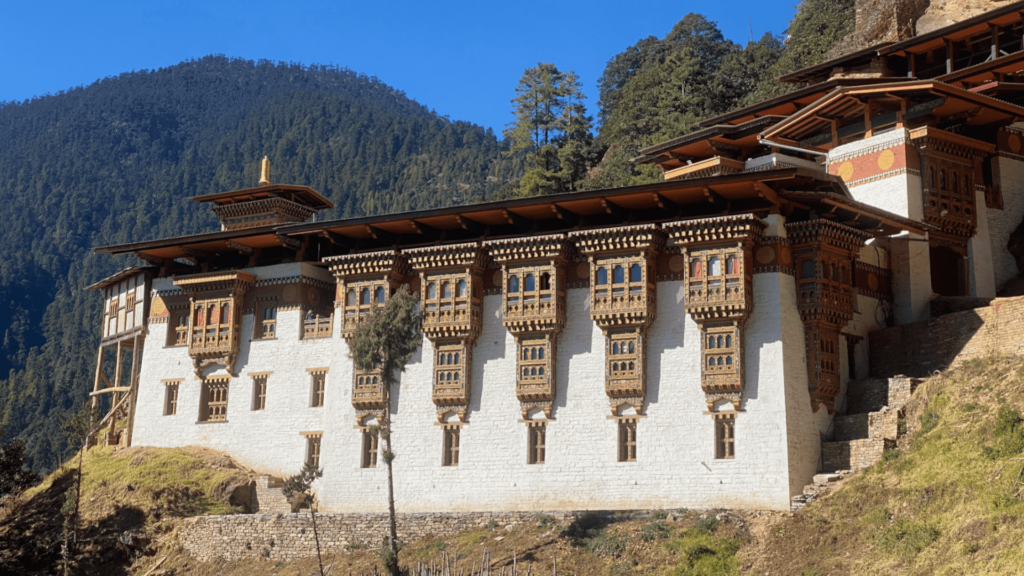
A visit to the Tango Monastery is a half hour drive towards upper Thimphu and then a nice offbeat one hour hike for till yiou reach the monastery. The path is a well laid one the is not too steep. Colorful prayerflags, nice resting places meditation huts, prayerwheels and chortens and beautiful pine trees are some of the sights you come across as you hike to the monastery. Tango Monastery is among the highest Buddhist learning Institutes in Bhutan. The monastery was founded by Lama Phajo Drugom Zhigpo in the 13th century. The Monastery was built in its present form in 1688 by Desi Tenzin Rabgye, the 4th Temporal Ruler.
Cheri Monastery
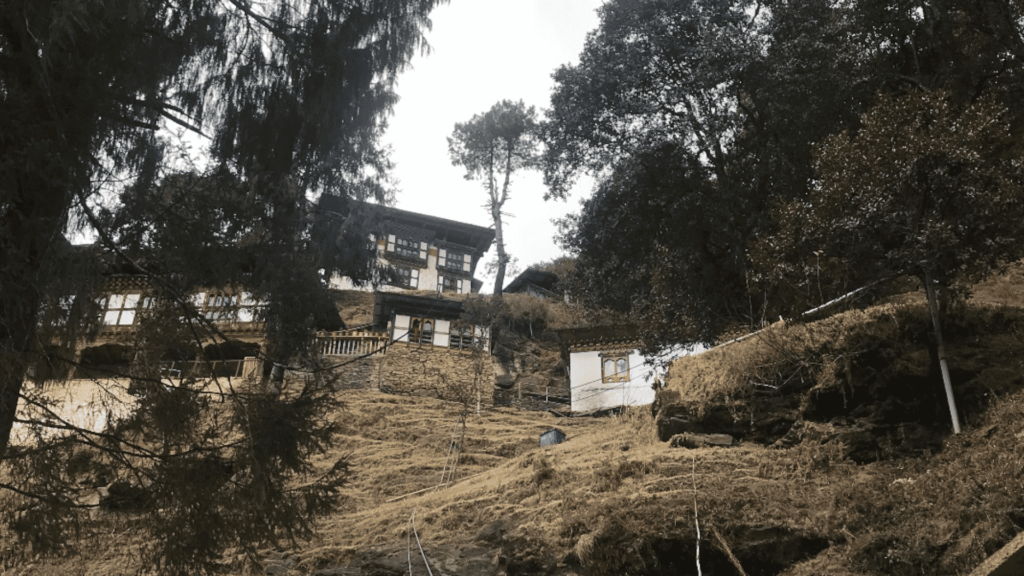
Cheri Monastery actuallly known as Chagri Dorjeden Monastery is a Buddhist Monastery eastablished in 1620 by Zhabdrung Ngawang Namgyal. The Monastery is a major teaching and retreat centre of the Drukpa Kagyu School of Buddhism in Bhutan. The Monastery sits on a hill above the end of the road at Dodeyna in the northern end of Thimphu opposite to the Tango Monastery. After a half hour drive to the end of Dodeyna Road, the monastery is an hours hike up the steep hill. However the trail is well maintained and easy to walk. You can come across gorals and other birds as you hike the hill among the lush green forest.
Simtokha Dzong
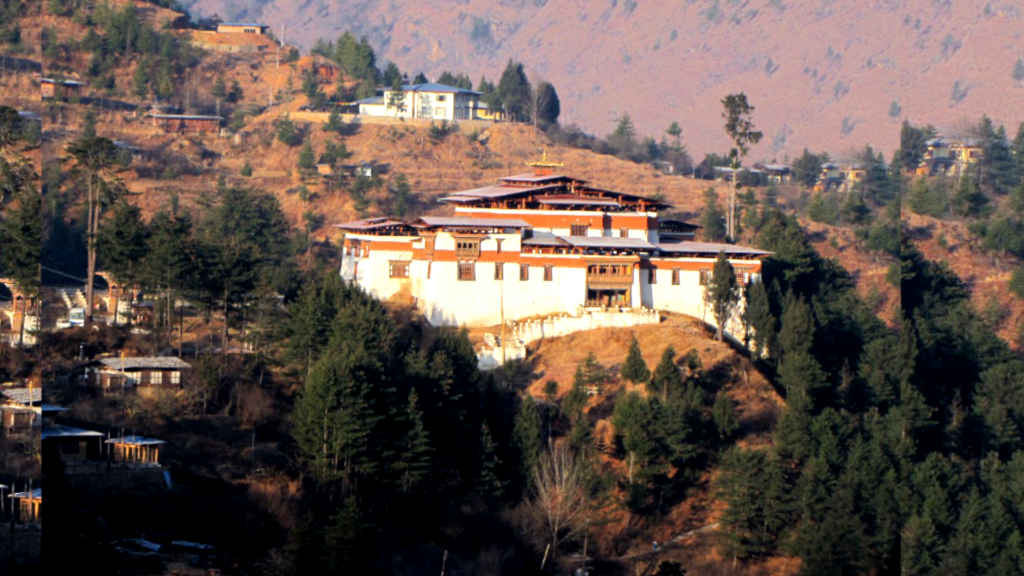
Built in 1629 by Zhabdrung Ngawang Namgyal, Simtokha Dzong strategically sits on a projecting ridge around 5 kms south of Thimphu City. The Dzong is also known by the name of “Sangak Zabdhon Phodrang”, meaning the Palace of Profound meaning of secret mantras” and is the the first dzong built in Bhutan by Zhabdrung Ngawang Namgyal. The entrance oif the Dzong is adorned by the Murals of Vaishravana (north), Dhritarashtra (east), Virudhaka (south) and Virupaksha (west) protecting the four cardinal direction. In 1670, the fortress was restored and expanded by the third Desi Mingyur Tenpa. The dzong has been enlarged and modified many times since then but the Original structures are still intact.
Dochula Pass and Druk Wangyel Temple
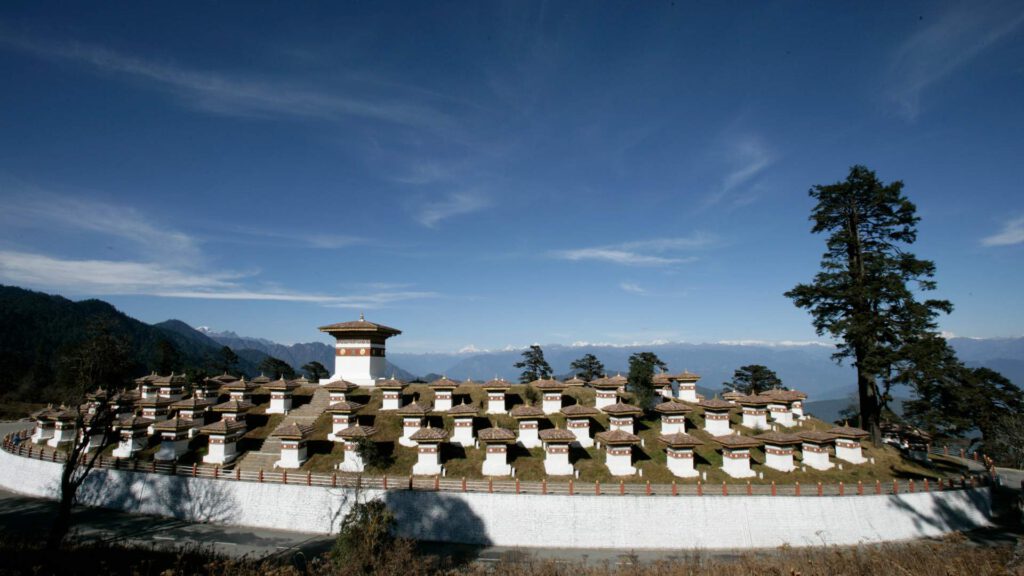
Dochula pass is the highest point between Thimphu and Puynakha/ Wangdue Valley. It is a beautiful Mountain Pass at an elevation of 3140 mts. The breath taking views, fluttering pratyer flags and the 108 Druk Wangyel Chhortens makes this place worth a visit. The 108 Druk Wangyel Chortens were built under the patronage by the Eldest Queen Mother Ashi Dorji Wangmo Wangchuck.
Just nearby is the Druk Wangyel Lhakhang crowning a hillock and overlooking the 108 chhortens. This lhakhang was built in honor of the Fourth King of Bhutan, His Majesty the King Jigme Singye Wanghuck.
Jungshi Handmade Paper Factory
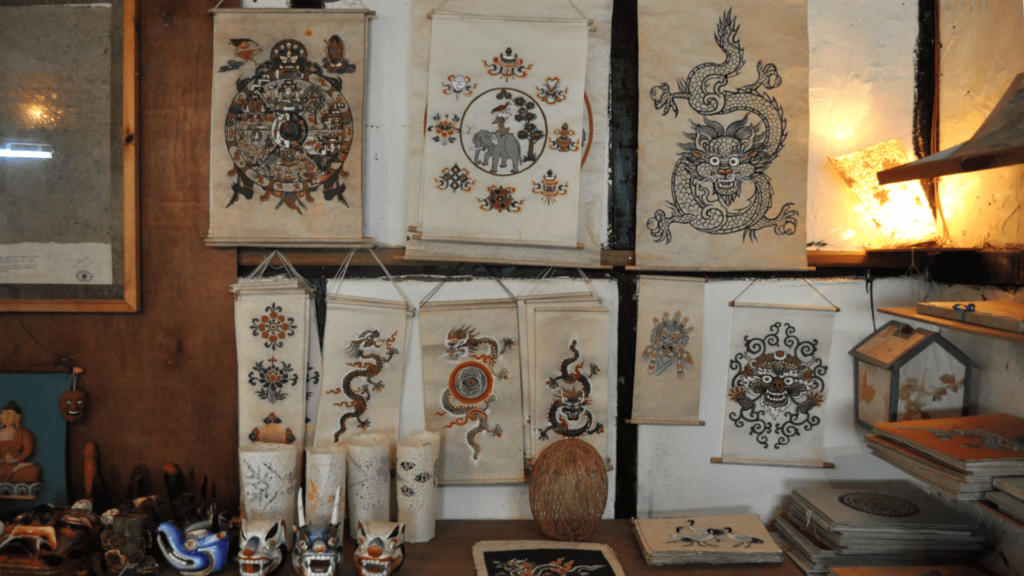
The Jungshi Hand Made Paper Factory is located just 1 km away from the Norzin lam Stree of Thimphu City. The factory is among the few existing traditional Bhutanese paper manufacturing places in Bhutan. The traditional paper is known as “Deh-sho” and the Factory was established in 1992 as a pilot program to preserve the traditional handmade paper making in Bhutan. The main raw material is the bark of the Daphne Tree and the tourist can witness the process of making the paper from its initial stage. The place also has a souvenir shop from where you can buy finished “Deh-sho” products.
Dechenphodrang Monastery
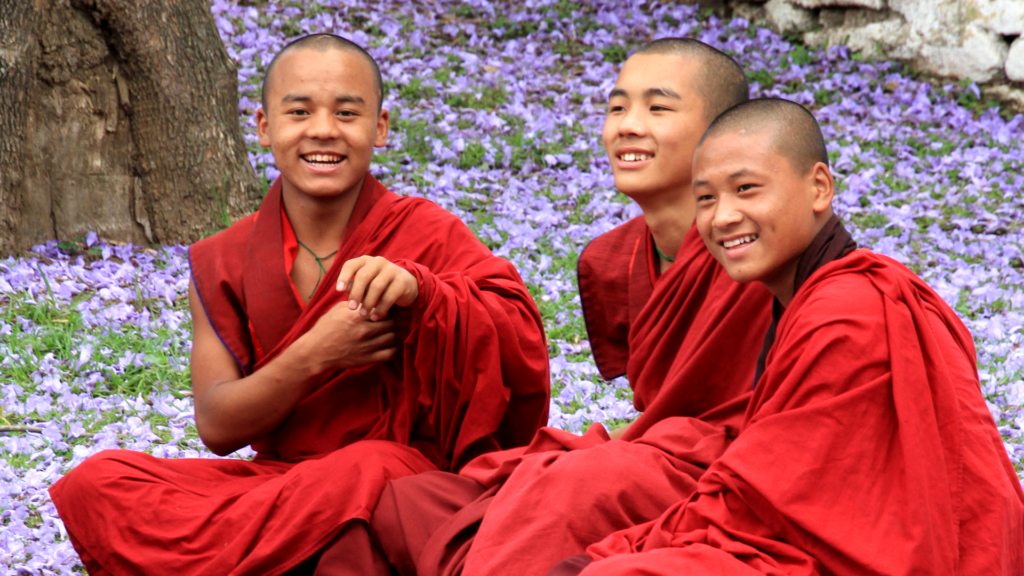
Dechen Phodrang means “Palace of Great Bliss”. This Monastery is located towards north of the Thimphu City is currently house around 500 monks enrolled in eight year courses. It was converted to a monasteic school in the year 1971 and contains historical artifacts and 13th centrury paintings which is monitored by the UNESCO. You will be able to see little monks if you are there during the breaks.
Clock Tower Square, Thimphu
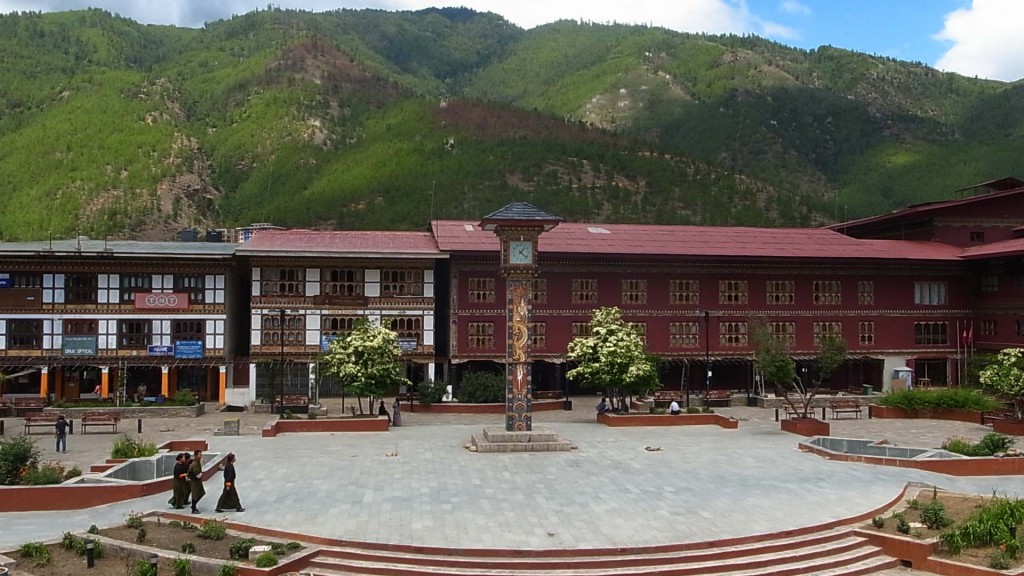
Just below the Norzin Lam, in the heart of Thimphu City is the Clock Tower Square. This is one of the most popular Land Marks in the Thimphu City and is the site of the famous tower with four clock faces. The place is kept busy by many events in the city and an evening walk around is a beautiful experience.
Changlimithang Stadium and Archery Ground
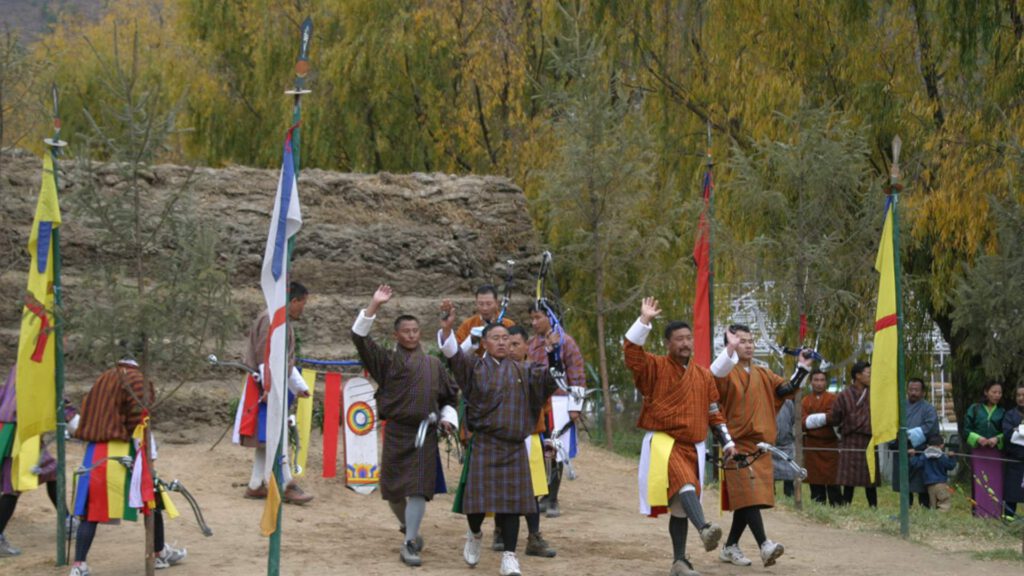
Archery is the national sport of Bhutan, and you may have the opportunity to witness a traditional archery match. The colorful costumes, lively atmosphere, and unique rules which make it a captivating experience. Despite many archery ranges all over the country from well established to some makeshift temporary ranges, Changlimithang National Stadium in Thimphu is the principal archery range where most of the national tournaments are held. The Changlimithang stadium is only of its kind in the whole country and is also a place of historic importance. Visit to the National Stadium shall be a nice experience and tourists can also have a hands-on experience of Archery, the National game of Bhutan. This hands on experience may be experienced in other places while traveling in Bhutan.
Centenary Park
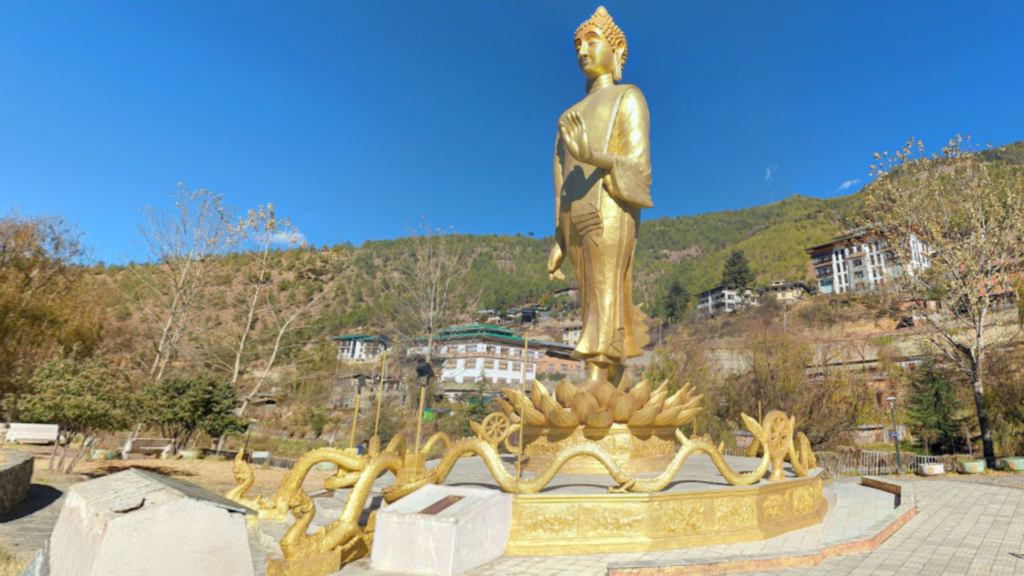
Centenary Children’s Park OR Coronation park OR just Centenary Park is one of the most popular Landmarks in Thimphu botth for the locals and the Tourist. It is a place which is loved both by kids and adults. For kids it is a nice place to play and for the Adults it is among the best places to relax or for a picnic with some beautiful sites for photography. The park was established to commemorate the 100th Anniversary of Monarchy in Bhutan. Ashi Chimi Yangzom Wangchuck inaugurated the Centenary and Coronation Park on 26 September 2006. The path is built in an area of 5.6 acres of land along the banks of Wangchu (Thimphu River). A 45 feet tall statue of a Walking Buddha was inagurated on 13th April 2012 celebrating the 84th Birth Anniversary of the King of Thailand and the Wedding anniversary of His Majesty, Jigme Khesar Namgyel Wangchuck, the fifth King of Bhutan.
Ludrong Memorial Garden
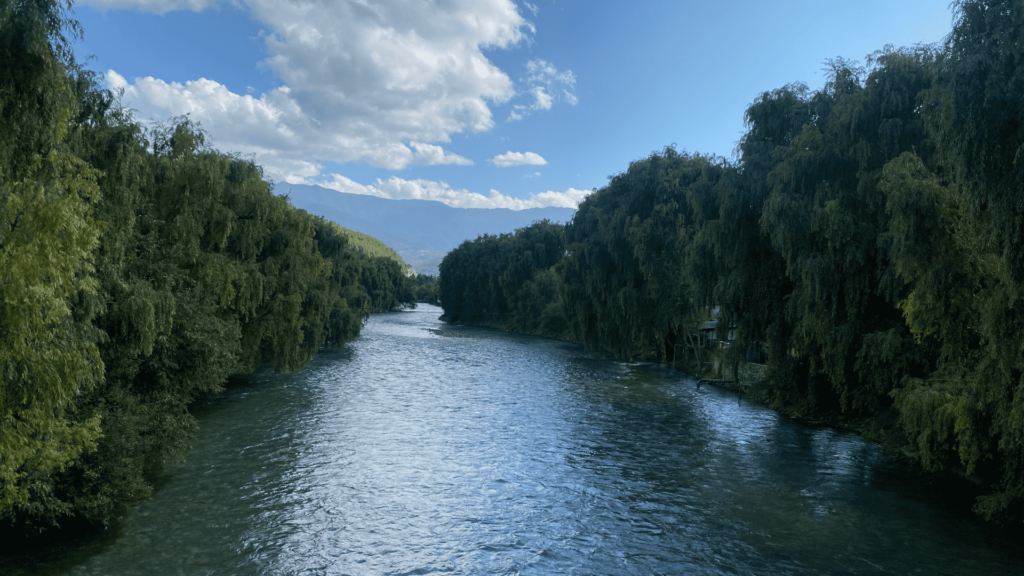
Ludrong Memorial Garden was inagurated on 21st may 2015 by the Fourth King of Bhutan, His Majesty the King Jigme Singye Wangchuck. It is a Gift to the people of Bhutan from the Royal Grand Mother, Her Majesty Ashi Kesang Choeden Wangchuck on Her Majesty’s 85th Birth Anniversary. “Ludrong” Means “the settlement of Nagas”, the garden lies between the Tashichhodzong and the Parliament Building spreading over 8.35 acres. Apart the nice picnic spot, a beautiful traditional bridge, breath taking views of the wang chhu and Tashichhodzong, the garden is also enriched with 560 varieties of tress, 362 scrub species, 385 bush species,1724 flower species and 75 fruit bearing trees. There are also ponds filled with brown trout, snow trout and carp fish species.
Royal Botanical Garden, Serbithang
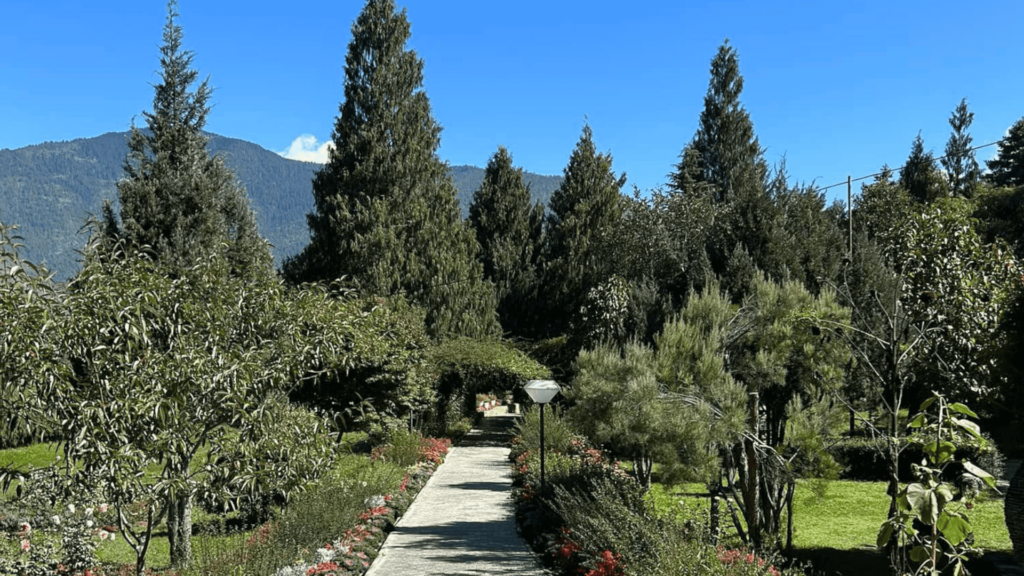
The Royal Botanical Garden in Serbithang, Thimphu was established in the year 1999. It was established to commemorate the Silver Jubilee Celebration of His Majesty the Fourth Druk Gyalpo. The main function of the garden is to act as an ex situ conservation area for the country’s flora and to educate the public on the value of conservation. Spanning over 28 acres, the garden is frequented by coordinated educational visits and is a favourite spot for family outings and picnics as well.
Nado Poizokhang, Thimphu
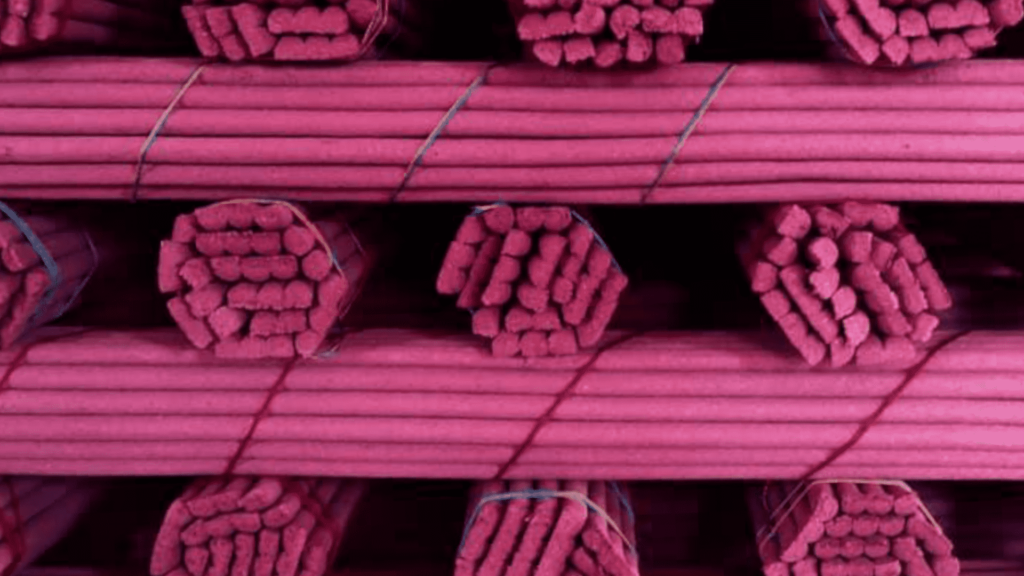
Nado Poizokhang is a family run business established in the year 199. It is Bhutan’s most popular and the oldest high quality hand-made Bhutanese incense manufacturer. It manufactures a wide variety of inscence products using natural herbs, medicinal plants, fruits, barks, flowers, leaves and roots. The products are prepared using age-old techniques dating back to 700 year before.
Pangrizampa School of Astrology and the Tara Temple
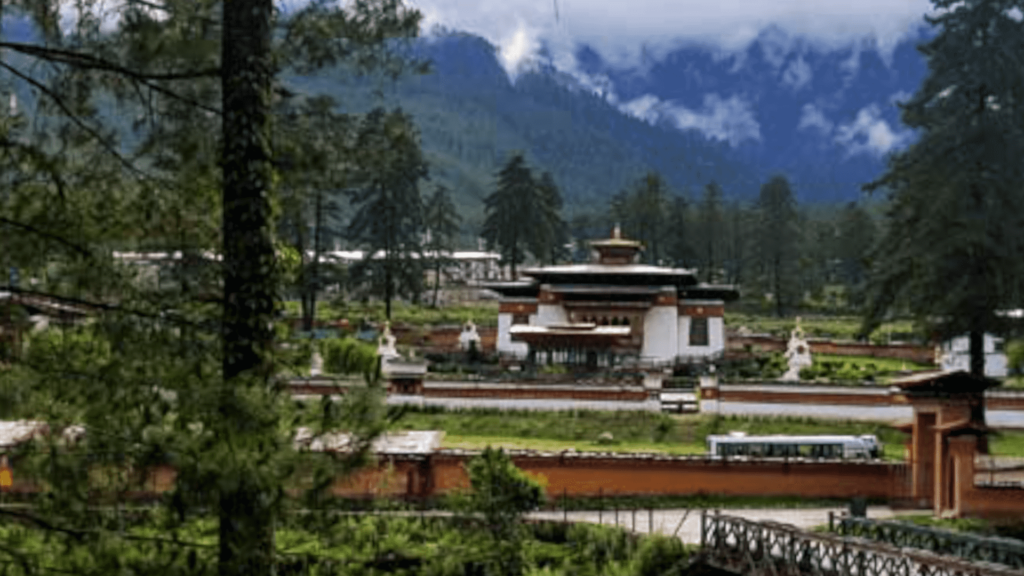
Located in North of Thimphu, the Pangrizampa School of Astrology was first established in the Sixteen Century by Zhabdrung Ngawang Namgyal. The name is derived from the from the cantilevered bridge beside the complex. There are two huge cypress trees in front of the temple which is believed to be the biggest in the country. The complex also houses the Drolmaq Zhingkham Lhakhang which was recently built by Her Majesty, the Royal Grandmother. The temple is dedicated 21 Images of Tara.
Weaving Centres in Thimphu
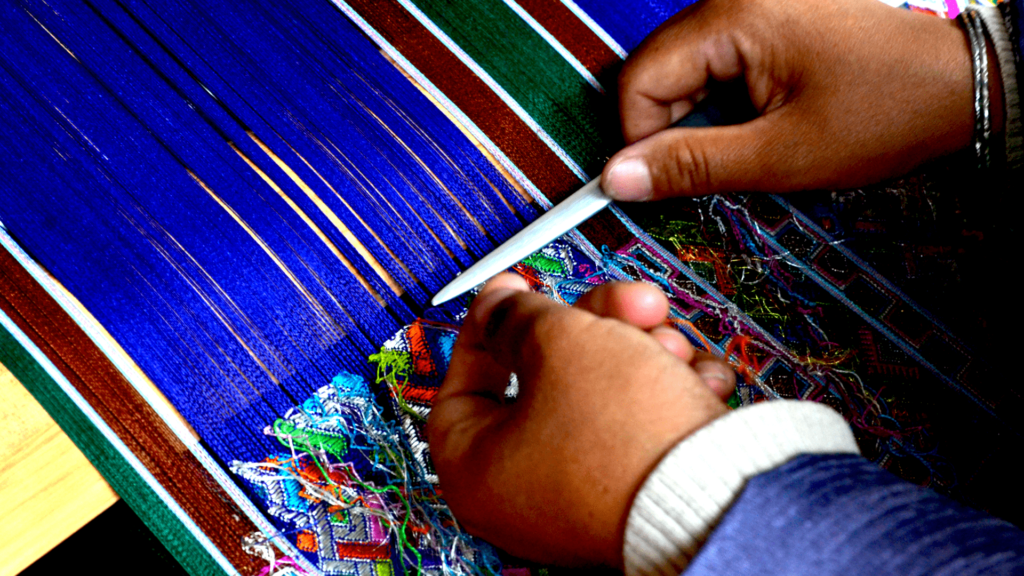
There a quite a number of private Weaving Centres in Thimphu which processes some of the finest traditional hand woven textiles. You could choose to visit any of these weaving centres in Thimphu. Visitors are greeted by the rhythmic clatter of looms operated by skilled artisans, their hands deftly maneuvering colorful threads to create intricate patterns that tell stories of Bhutanese folklore. The Weaving Center is not merely a workshop; it is a living museum, where visitors can witness the process of weaving traditional Bhutanese textiles by Bhutanese Women. Visitors have the unique opportunity to engage with the weavers, gaining insights into the significance of each motif and the stories woven into every fabric.
Zangtopelri Lhakhang, Thimphu
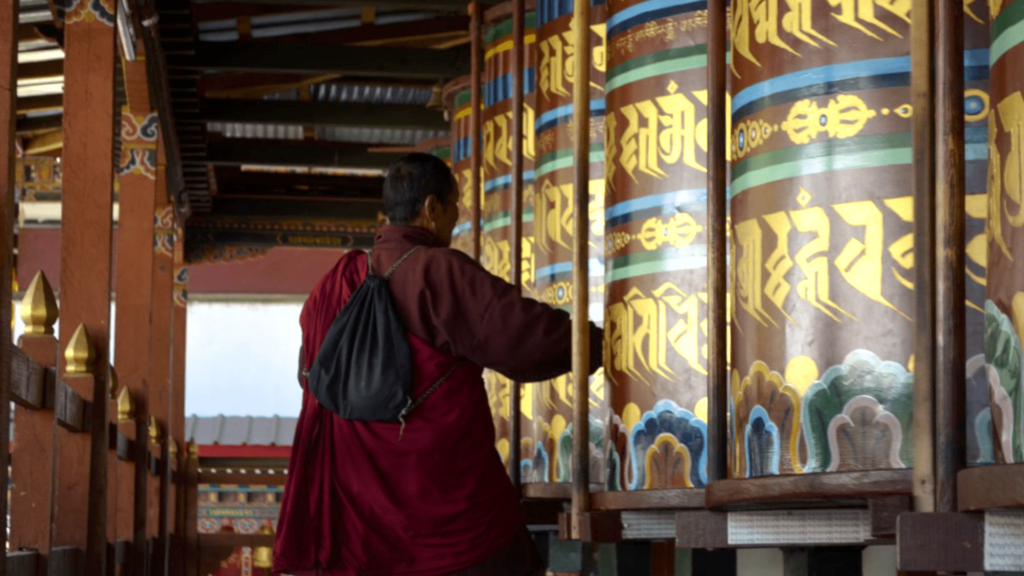
The Zangto Pelri Lhakhang is located close to the Centenary Farmers Market was built in 1990 by Dasho Aku Tongmi. The temple is the representation of Guru Rinpoche’s celestial abode. Dasho Aku Tongmi was one of the most respected musician who composed the national anthem of Bhutan.
Wangditse Goemba, Thimphu
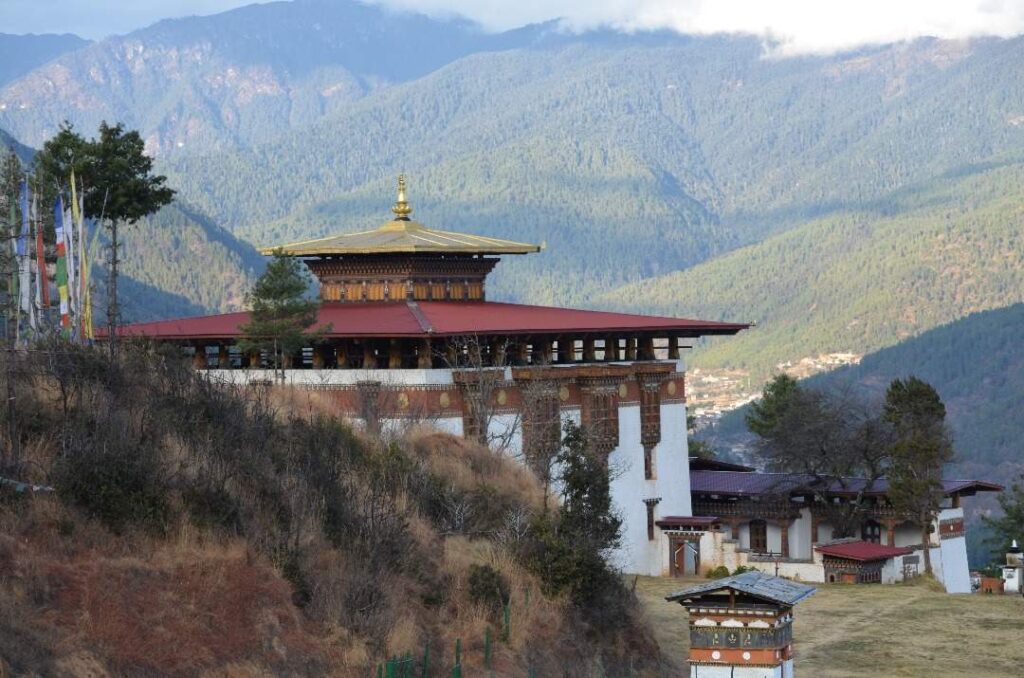
The Wangditse Goemba or the Druk Wangditse Lhakhang was established in 1715 as the seat of the 8th Druk Desi, Druk Rabgye. The name of the Lhakhang means “Temple of the Peak of Conquest” and is among the oldest temples in the Thimphu Valley. It is located on the ridge above Tashichhodzong overlooking the whole Thimphu Valley and is about hour of Hike from Sangaygang Viewpoint. The lhakhang was damaged during the earthquake on the 2011 and was rebuilt. The temple was re-consecrated in the year 2020 by the Laytshog Lopon, Sangay Dorji, of the Zhung Dratshang. A two-storey high statue of Sakyamuni Buddha which was salvaged from the original Monastery is the main highlight of this monastery.
Trashigang Goemba, Thimphu
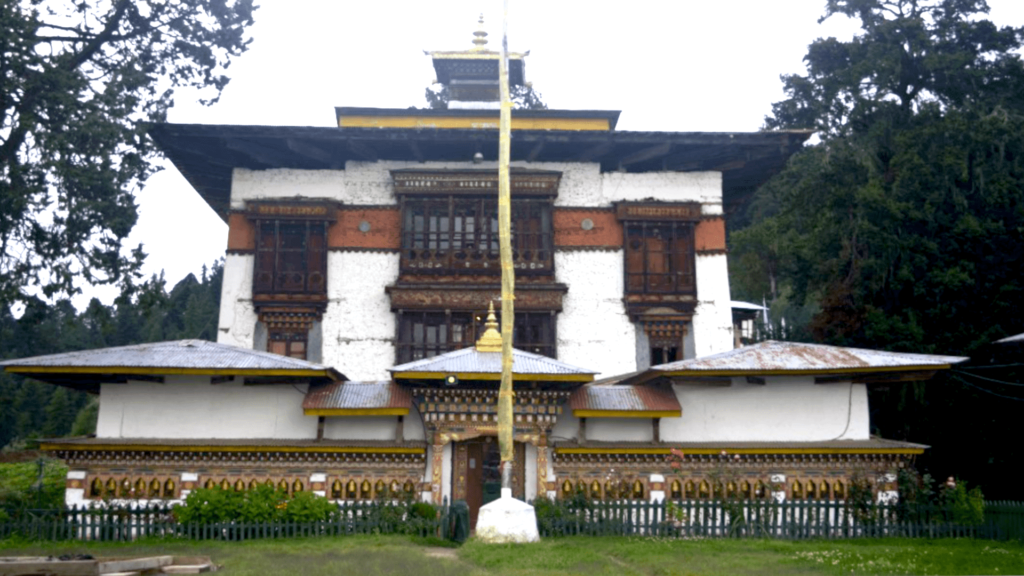
Tashigang Goemba, also known as Lha-Dzong Trashigang is the heavenly place of the 12th je-Khenpo, Jetsun uenga Gamtsho. It was established in 1782 and is an important meditation center for around 16 monks and a few Nuns. It is approximately 30 Kms from Thimphu city and can be reached either by taking a dirt road of 10 Km from the highway or by doing the Lunchutse Hike of approximately 3 hours through a forest of Hemlock or rhododendrons.
Trashigang Goemba, Thimphu

Tashigang Goemba, also known as Lha-Dzong Trashigang is the heavenly place of the 12th je-Khenpo, Jetsun uenga Gamtsho. It was established in 1782 and is an important meditation center for around 16 monks and a few Nuns. It is approximately 30 Kms from Thimphu city and can be reached either by taking a dirt road of 10 Km from the highway or by doing the Lunchutse Hike of approximately 3 hours through a forest of Hemlock or rhododendrons.

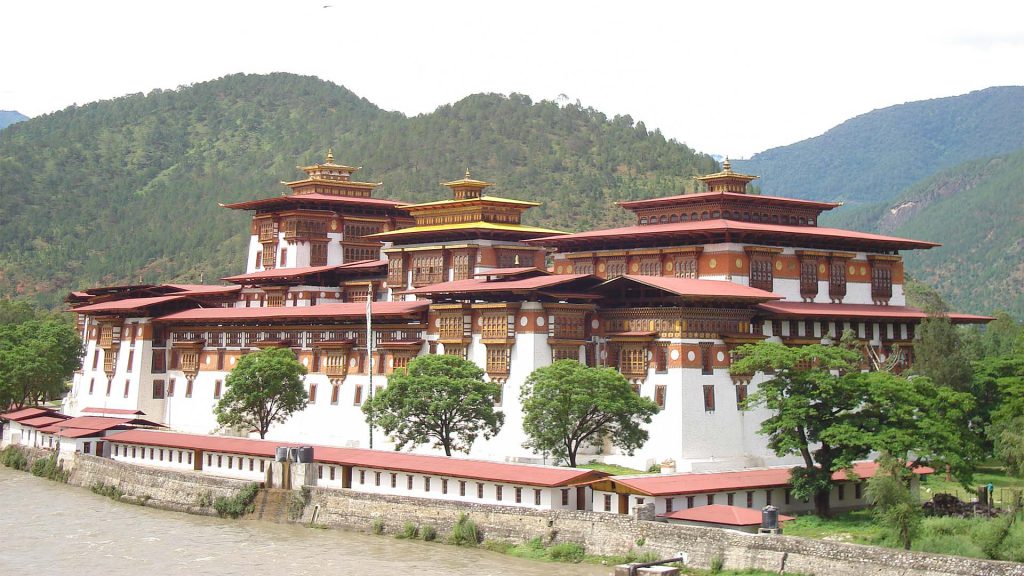
Punakha
A fertile valley with temperate climate, Punakha served as old capital till 1955. It still serves as the winter seat of the monk body. River rafting is popular here both …..
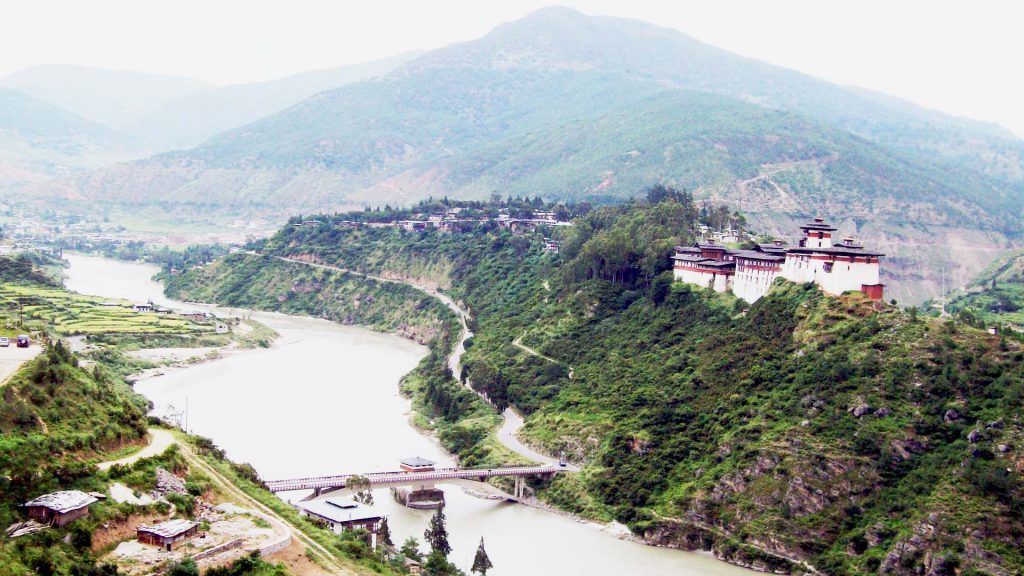
Wangdue
Wangduephodrang district, popularly known as simply Wangdue is adjacent to Punakha. the main towns of these districts are approximately 10 km apart…..
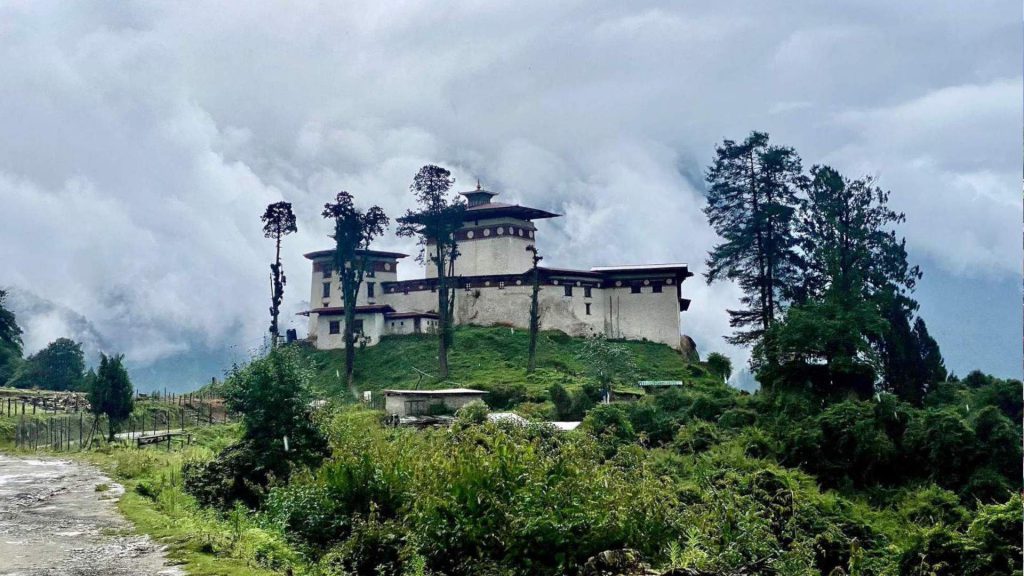
Gasa
Gasa is the northernmost district of the Western Bhutan and is the least populated one. The recent road connection to this place is increasing its popularity amongst.
